Intel's Pentium M Desktop Part II: ASUS' Pentium M to Pentium 4 Socket Adapter
by Anand Lal Shimpi on March 24, 2005 1:31 PM EST- Posted in
- CPUs
Business/General Use Performance
Business Winstone 2004
Business Winstone 2004 tests the following applications in various usage scenarios:- Microsoft Access 2002
- Microsoft Excel 2002
- Microsoft FrontPage 2002
- Microsoft Outlook 2002
- Microsoft PowerPoint 2002
- Microsoft Project 2002
- Microsoft Word 2002
- Norton AntiVirus Professional Edition 2003
- WinZip 8.1
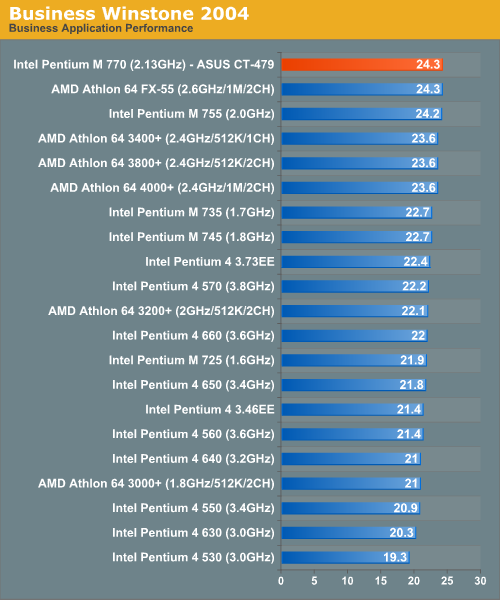
Office Productivity SYSMark 2004
SYSMark's Office Productivity suite consists of three tests, the first of which is the Communication test. The Communication test consists of the following:"The user receives an email in Outlook 2002 that contains a collection of documents in a zip file. The user reviews his email and updates his calendar while VirusScan 7.0 scans the system. The corporate web site is viewed in Internet Explorer 6.0. Finally, Internet Explorer is used to look at samples of the web pages and documents created during the scenario."
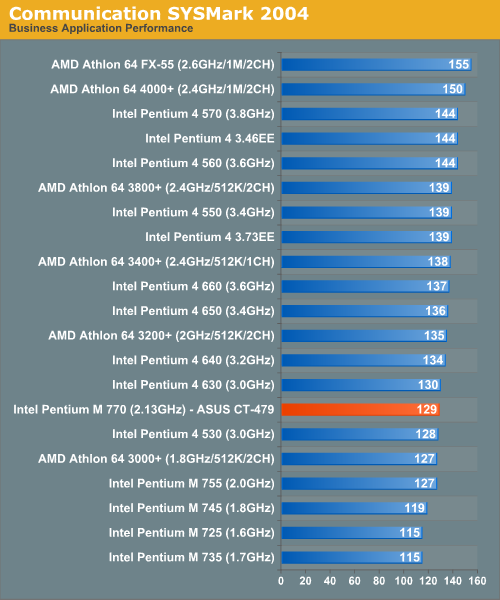
The next test is Document Creation performance:
"The user edits the document using Word 2002. He transcribes an audio file into a document using Dragon NaturallySpeaking 6. Once the document has all the necessary pieces in place, the user changes it into a portable format for easy and secure distribution using Acrobat 5.0.5. The user creates a marketing presentation in PowerPoint 2002 and adds elements to a slide show template."
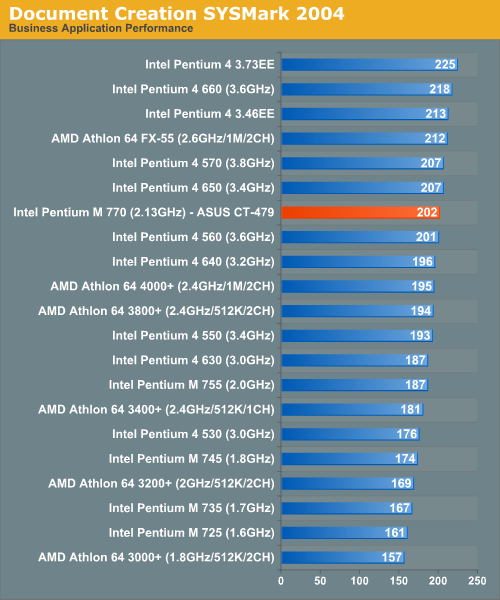
The final test in our Office Productivity suite is Data Analysis, which BAPCo describes as:
"The user opens a database using Access 2002 and runs some queries. A collection of documents are archived using WinZip 8.1. The queries' results are imported into a spreadsheet using Excel 2002 and are used to generate graphical charts."
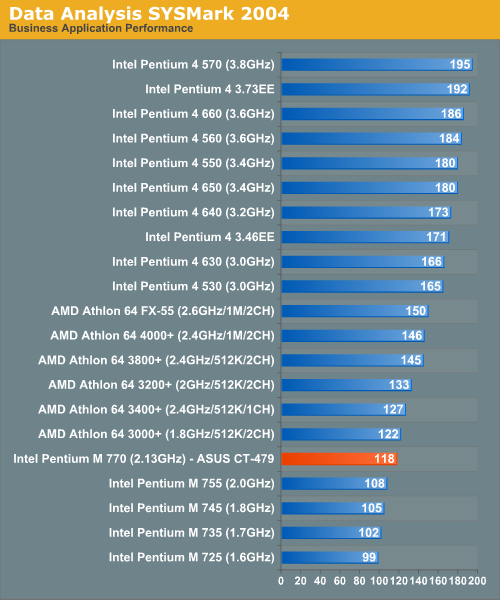
Mozilla 1.4
Quite possibly the most frequently used application on any desktop is the one that we pay the least amount of attention when it comes to performance. While a bit older than the core that is now used in Firefox, performance in Mozilla is worth looking at as many users are switching from IE to a much more capable browser on the PC - Firefox.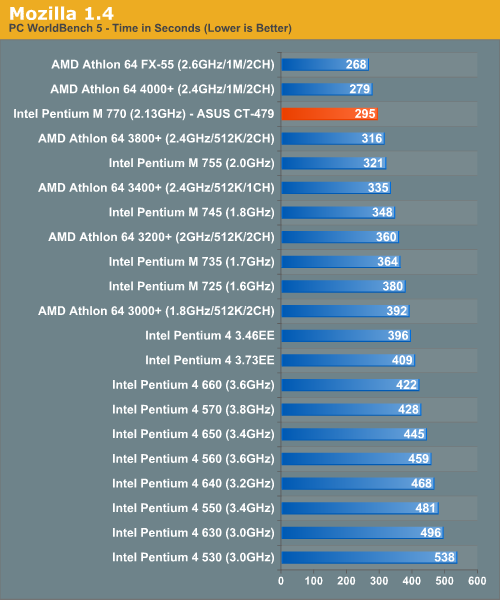
ACD Systems ACDSee PowerPack 5.0
ACDSee is a popular image editing tool that is great for basic image editing options such as batch resizing, rotating, cropping and other such features that are too elementary to justify purchasing something as powerful as Photoshop. There are no extremely complex filters here, just pure batch image processing.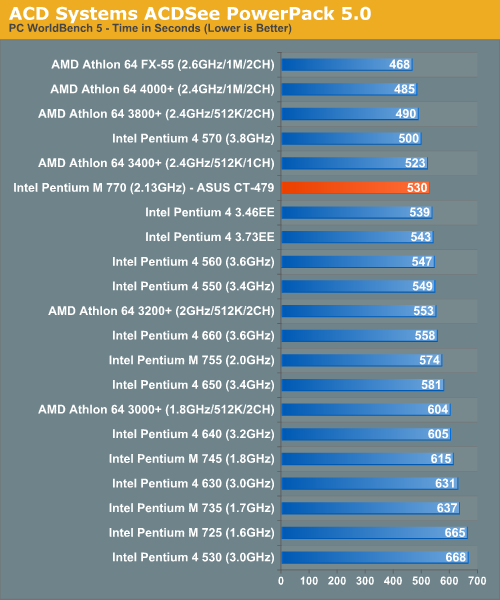
Winzip
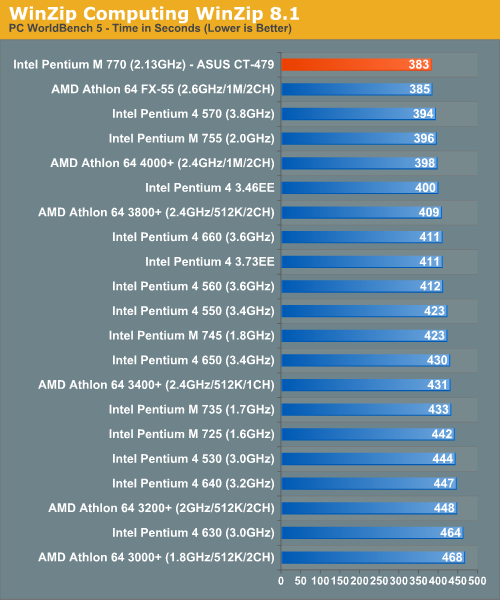
Let's look at how its peak theoretical performance is under WinRAR's built in benchmark:
WinRAR 3.40
Pulling the hard disk out of the equation, we can get a much better idea of which processors are truly best suited for file compression.










48 Comments
View All Comments
Avalon - Thursday, March 24, 2005 - link
In Soviet Russia, the Pentium-M owns you!In all seriousness, though...I was reading the benchmarks and wondering where the 855GME desktop P-M 770 benchmarks were. You only had the 770 on the Asus board. While this is all fine and dandy, it doesn't show us the full extent of the benefits of the Asus pin adapter over using an 855GME desktop board. While you could extra some data, I would have liked 770 desktop benches as a comparison. All in all, though, the Asus adapter is definitely nice due to the price alone.
Wonga - Thursday, March 24, 2005 - link
I don't think anyone can criticise Intel too harshly for releasing the Netburst architecture. Yes, Willamet stank, and Prescott isn't exactly an efficient core, but a Northwood processor was the best CPU money could buy for about 18 months before the K8 hit the scene. So, it doesn't really matter how Intel got there, but Netburst was the architecture to have for those 18 months.Anyway, Anand, I'd appreciate it if you could see if those adaptors would work on other S478 motherboards :)
Oh, and thanks for a great article! Perhaps that Pentium M horse that was beaten so much can now finally rest in peace!
sprockkets - Thursday, March 24, 2005 - link
While the boards and tech mentioned here are nice, why not also test some of the PM mini-itx boards at www.logicsupply.com and see how badly it can kick an Mac Mini's ass? OR, how well it can perform in such small space with little heat and noise output?xtknight - Thursday, March 24, 2005 - link
amazing it beats the fx-55 at q3 source compile. maybe i need to get my eyes checked but does that say INTEL?mkruer - Thursday, March 24, 2005 - link
Here is what I get out of this,1. P-M is better clock then the P4 and apparently the AMD64, (at least in some applications)
2. Future versions of the P-M while adding better FP and SSEx Instructions will still not have 64-bit technology.
3. Adding better FP and SSEx, will also increase the minimal thermal rating, resulting in a lower maximum over clocking ability, and higher heat dissipation
All and all, it looks to be about the same as AMD64, when all the upgrades are added in.
ncage - Thursday, March 24, 2005 - link
#5 It probably wouldn't be that good for intel to drop Pentium M prices. Yes there would get more sales from techies like us but that wouldn't increase there sales that much. Where they get sales would be from labtops and their profit margins would drop for that that is why overall it would be stupid for intel to drop the prices on them.mlittl3 - Thursday, March 24, 2005 - link
I'm sorry but I have to say a few more things.I counted up all the benchmarks (not including overclocking ones) and the 2.13 GHz PM beats a 3.2 GHz PIV in 22 out of 33 benchmarks. For a 1 GHz+ underclocked processor, the PM wins in two-thirds of the benchmarks. Now correct me if I'm wrong but doesn't the 2.13 GHz PM consume 25W of power and the 3.2 GHz PIV consume around 100W. That's four times the power for 66% less performance.
Multiply that 4x waste by all the PIV's that Intel sold and we must have wasted megawatts upon megawatts of power for nothing. You can't say its technology improving because the PM is based on old technology.
Intel wasted so much electricity and polluted so much more of the environment because what it couldn't save face when it released the 1.13 GHz coppermine PIII and had to recall it because of architectural problems. Therefore, it had to release the PIV to make itself look better from a marketing standpoint.
This just blows my mind.
EODetroit - Thursday, March 24, 2005 - link
Nice article. While now we know that the Pentium M probably isn't practical for the desktop in most situations when price is considered, this review is important because it gives us something to compare the Yonah processors to when they come out. And those of us that were curious about the P-M on the desktop finally have some answers, so thanks for that.How high could it overclock, anyways? It sounded like you got it up to the point where the memory would be at DDR400 with the 5:4 ratio, and called it good. But how much more can it be pushed? What about with better cooling?
Googer - Thursday, March 24, 2005 - link
Thank God there are no Russian Jokes on this page!Googer - Thursday, March 24, 2005 - link
I did not see any benchmarks of the Pentium M 770 on the 855GME so we could compaire APPLES to APPLES the only system it was run on was 865, It's a bit of an unbalanced compairison. Anand, Just how much of a differance does 865 offer the P-M 770 over 855?